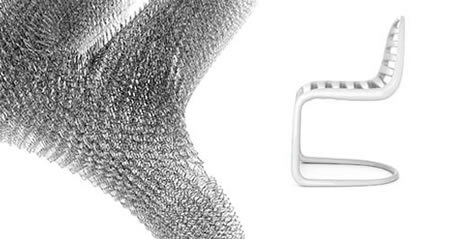Sean Hanna is a very interesting architect/engineer that takes inspiration from nature for a variety of projects. The PAN_07 chair which was designed and manufactured in collaboration with Timothy Schreiber takes inspiration from advanced cellular lattices that occur in nature to minimize weight but maximize resistance to force. We’ve seen these methods adopted by various other projects here including Andre Harris‘s Bone inspired design, as well as Revano Satria‘s and Matsys Architecture‘s cellular research. More images and ideas…
Sean explained the project as follows:
“Based on an analogy with the highly efficient cellular structure of living wood or bone, which adapts to its environment as it grows, the chair’s interior is comprised of a fine lattice that minimizes weight while maximizing strength. The design method combines principles of evolution and artificial intelligence to create a material that responds to its environment by growing denser in the areas required to best withstand the external forces applied when the chair is in use.”

The project would be plenty interesting if we stopped right there but it gets better:
“The composition of the cells is the result of a computational process directly modelled on nature that creates a modular space frame structure of tiny interconnected struts, specifically suited to the material and fabrication process. A genetic algorithm, using the principles of natural evolution, has been used to generate the topology of the structural cells. Using machine learning techniques each one is given just enough intelligence to reorient itself or change its shape, size or structure depending on where it sits in the body of the chair. A section through the vertical leg of the chair, for example, reveals cells with a greater density toward the surface to counter the higher tensile or compressive stresses that result as it bends.
This sort of control over the inner properties of the material is only possible with today’s modern digital fabrication technology. Now imagine applying this technology to an entire building, the results would be very fascinating. Sean comments on this new paradigm as well:
“[This project] has broad implications in terms of our concept of materials, emphasising continuity and gradual transition as opposed to a traditional assembly of parts. The technology currently operates at the millimetre rather than the nanometre scale, but to a degree these technologies can free the designer from having to select from a pre-existing palette of materials and allow one to specify any density, Poisson’s ratio or dynamic anisotropy desired. More importantly, these properties can seamlessly blend from one to the next without joints, gaps or mechanical fixing.”

So like i said, imagine organic designs not having to be reconfigured and re assembled within a traditional framework of beams and columns, the design itself would be entirely self contained from a materials standpoint.
Sean also added:
“The sintered nylon prototype detail is comprised of approximately 50,000 individual and unique structural units, a small portion of the millions that would form the entire chair. Current research is underway to streamline the flow from optimisation to fabrication, so that objects of such complexity may be customised in real time.”
More posts on Sean Hanna: Responsive Materials
Interview with Timothy Schreiber

